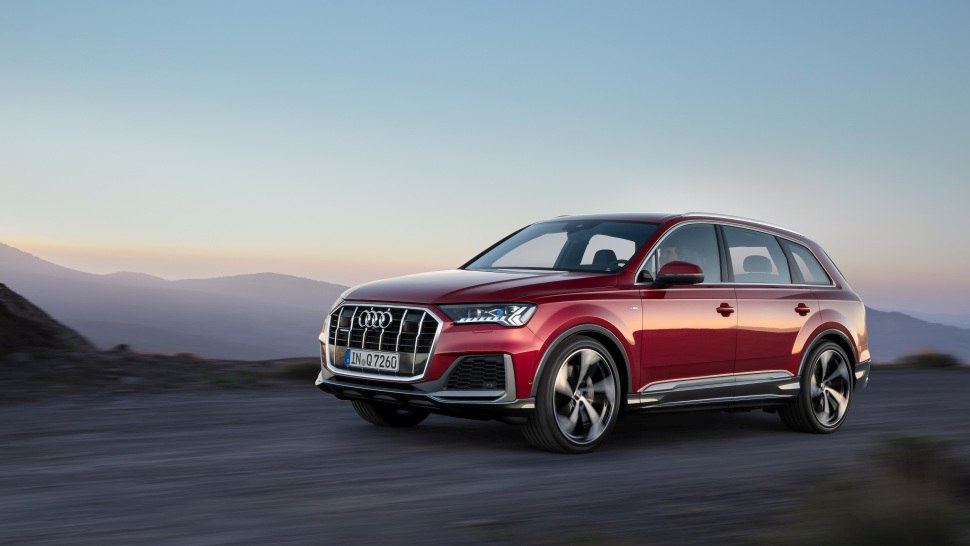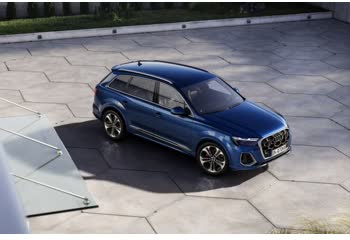Everything you need to know about specifications and performance - Audi Q7 2019 - 50 TDI V6 (286 Hp) Mild Hybrid quattro tiptronic

Overview:
What is the engine capacity of a Audi Q7 2019?
The engine capacity of the Audi Q7 2019 is 2967.
Audi Q7 2019 How many horsepower?
The engine power of the Audi Q7 2019 is 286 Hp @ 3500-4000 rpm..
What is the Audi Q7 2019 engine?
Audi Q7 2019 engine is EA897evo2 / DHXA. (Click to see other cars using the same engine)
How much gasoline does a Audi Q7 2019 consume?
The Audi Q7 2019 consumes 6.6-6.8 liters of gasoline per 100 km
General:
Brand: Audi
Model: Q7
Generation: Q7 (Typ 4M, facelift 2019)
Modification (Engine): 50 TDI V6 (286 Hp) Mild Hybrid Quattro Tiptronic
Start of production: September, 2019
End of production: October, 2020
Powertrain Architecture:MHEV (Mild Hybrid Electric Vehicle, power-assist hybrid, battery-assisted hybrid vehicles, BAHV)
Body type:Sports Utility Vehicle (SUV)
Seats: 5
Doors: 5
Engine:
Engine systems: Start & Stop System
Power: 286 hp @ 3500-4000 rpm.
Power per litre: 96.4 hp/l
Torque: 600 nm @ 2250-3250 rpm.
Engine Model/Code:EA897evo2 / DHXA
Engine displacement: 2967
Number of cylinders: 6
Engine configuration: V-engine
Number of valves per cylinder: 4
Fuel injection system: Diesel Commonrail
Engine aspiration: Turbocharger, Intercooler
Valvetrain: DOHC
Engine oil capacity: 6.1 l
Coolant: 15 l
Engine layout: Front, Longitudinal
Cylinder Bore: 83 mm
Piston Stroke: 91.4 mm
Compression ratio: 16:1
Performance:
Fuel Type: Diesel
Fuel consumption (economy) - urban: 7.2-7.3 l/100 km
Fuel consumption (economy) - extra urban: 6.3-6.4 l/100 km
Fuel consumption (economy) - combined: 6.6-6.8 l/100 km
Emission standard: Euro 6d-TEMP-EVAP-ISC
Acceleration 0 - 100 km/h: 6.5 sec
Acceleration 0 - 62 mph: 6.5 sec
Maximum speed: 241 km/h
Weight-to-power ratio: 7.3 kg/Hp, 136.8 Hp/tonne
Weight-to-torque ratio: 3.5 kg/Nm, 287.1 Nm/tonne
Acceleration 0 - 60 mph: 6.2 sec
Electric system:
Gross battery capacity: 0.5 kWh
Battery technology: Lithium-ion (Li-Ion)
Battery location: Under the trunk
Battery voltage: 48 V
Recuperation output: 8 kW
Space:
Kerb Weight (kg): 2090
Max. weight (kg): 2850
Max. roof load: 100 kg
Max load (kg): 760
Trunk (boot) space - maximum: 2050 l
Trunk (boot) space - minimum: 865 l
Permitted trailer load with brakes (12%): 2700 kg
Fuel tank capacity: 75 l
AdBlue tank: 24 l
Permitted trailer load without brakes: 750 kg
Permitted towbar download: 115 kg
Permitted trailer load with brakes (8%): 2700 kg
dimensions:
Length: 5063 mm
Width: 1970 mm
Height: 1741 mm
wheelbase: 2994 mm
Width including mirrors: 2212 mm
Front track: 1679 mm
Rear (Back) track: 1691 mm
Front overhang: 977 mm
Rear overhang: 1092 mm
Minimum turning circle (turning diameter): 12.5 m
Approach angle: 15.6°
Departure angle: 24.1°
Powertrain, Suspension and Brakes:
Drivetrain Architecture: The Internal combustion Engine (ICE) and the electric motor permanently drive the four wheels of the car with the ability to work only in mixed mode.
Drive wheel: All wheel drive (4x4)
Number of gears and type of gearbox: 8 gears, automatic transmission Tiptronic
Front brakes: Ventilated discs
Rear brakes: Ventilated discs
Assisting systems: ABS (Anti-lock braking system)
Steering type: Steering rack and pinion
Power steering: Electric Steering
Tires size: 255/60 R18; 255/55 R19; 285/45 R20; 285/40 R21; 285/35 R22
Wheel rims size: 8J x 18; 8.5J x 19; 9J x 20; 9.5J x 21; 10J x 22
Front suspension: Independent multi-link suspension, Air Suspension - Optional
Rear suspension: Independent multi-link suspension, Air Suspension - Optional
See also

Other generation.
Its production began in 2024 until Now
Write a comment